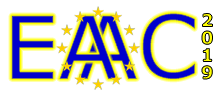Speaker
Description
Next generation accelerators demand sophisticated beam sources to produce ultra-low emittances with large gradients. The subsequent beamline optics are equally critical to transporting these beams between accelerating stages or to interaction points. Capillary discharge plasmas may address each of these challenges. Capillaries have been demonstrated as sources capable of increasing the peak energy and beam quality of laser wakefield accelerators, and as active plasma lenses featuring orders-of-magnitude increases in peak magnetic field. These systems are sensitive to energy deposition, heat transfer, ionization dynamics, and magnetic field penetration; therefore, improved modeling will enable advances in capillary design. We present simulations of capillary discharge waveguides and active plasma lenses in using FLASH, a publicly-available multi-physics code in development at the University of Chicago. We report on the implementation of a 2D, cylindrically symmetric capillary model for capturing plasma density and temperature evolution with realistic conductivities and magnetic fields. We then illustrate the use of laser energy deposition to model low density channel formation for the matching and guiding of intense laser pulses. Lastly, we discuss simulations of active capillary plasmas with different fill species, which show agreement with experimental observations of nonlinearities in the current density profile and magnetic field.

